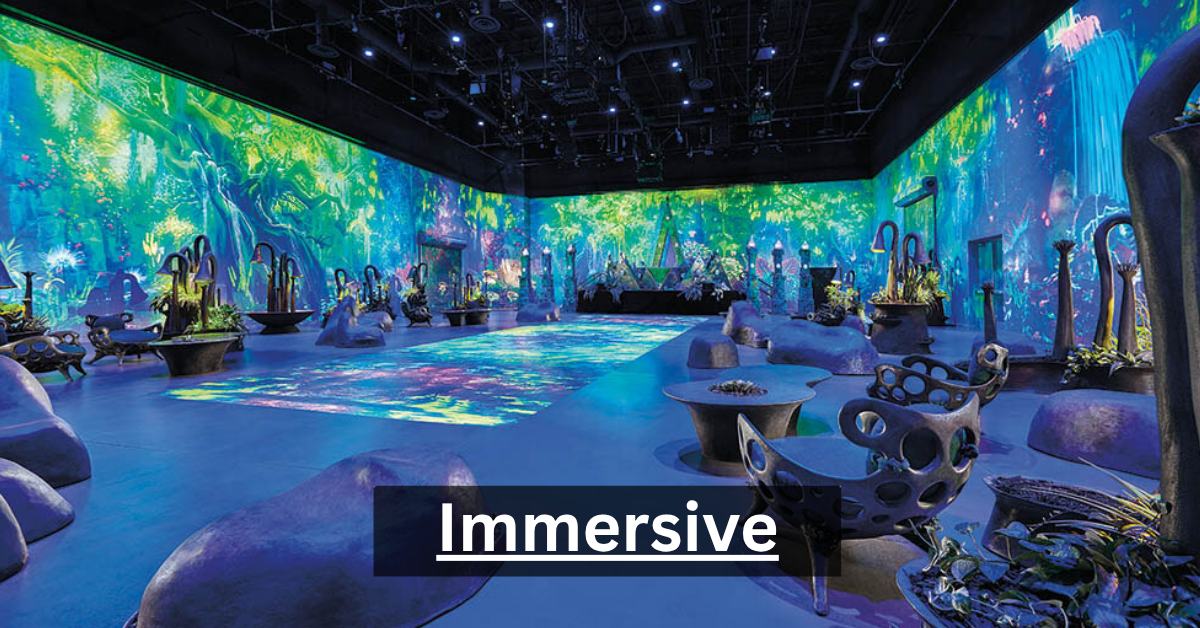Immersive web design crafts engaging digital spaces using 3D, multimedia, and interactivity to deliver a rich, personalized user experience. When we talk about “immersive,” we refer to technology and design that pull users into an environment, blurring the lines between the digital and physical worlds. These experiences can range from virtual reality (VR) and augmented reality (AR) to interactive websites and 3D environments, all designed to create deeper, more engaging user interactions.
In today’s digital age, immersion isn’t just a luxury – it’s becoming a necessity. Users now expect websites and media to offer engaging, dynamic, and lifelike experiences. With the rapid development of tools like Unity 3D and WebXR, designers are now able to create experiences that keep users engaged for longer periods and increase overall satisfaction.
Defining Immersive Experiences
Immersive experiences involve using technology to create environments that feel all-encompassing and lifelike. Whether through 360-degree video, interactive gaming, or augmented reality applications, the goal is to make users feel as if they’re part of the environment they’re interacting with. For example, Google Cardboard allows users to experience virtual reality using just their phone, while Oculus Rift and Oculus Quest offer a more advanced, fully immersive VR experience.
At the heart of immersive experiences is interactive technology – elements that allow users to engage with their environment in real-time. This could be anything from simple clicks on a webpage to more complex actions like moving through a 3D space or manipulating interactive models. Immersive storytelling, a growing trend in the film and advertising industries, uses this interaction to create narratives that unfold based on the user’s actions.
The Role of Front-End Development in Immersive Websites
When it comes to building immersive websites, a front end development company plays a pivotal role in ensuring that users can interact seamlessly with dynamic elements. These companies specialize in creating visually engaging interfaces that utilize immersive technologies such as interactive 3D models, 360-degree video, and augmented reality (AR). By using advanced web development technologies and frameworks, front-end developers create interfaces that allow users to engage with immersive content in real time. Their expertise in UX design and interactive web design ensures that websites are not only visually appealing but also user-friendly, providing a smooth and intuitive experience across all devices.
Importance of Immersive Technology in Modern Web Design
In the world of web design, immersive design is quickly becoming a cornerstone of user engagement. As technology evolves, users have grown accustomed to high-quality visual content and smooth interactions. Web design innovation now includes interactive web design techniques like parallax scrolling, which creates an illusion of depth, as well as multimedia integration, such as video, 3D models, and interactive graphics.
These technologies make websites not only more visually engaging but also more interactive, creating deeper emotional connections with visitors. A mobile-first immersive website might incorporate haptic feedback and 360-degree photography to enhance the user experience. For businesses, this means longer time spent on site, increased conversions, and ultimately, greater customer satisfaction.
Why “Immersive” is the Future of User Engagement
The future of user engagement lies in making digital interactions feel more personal, immediate, and memorable. Traditional websites, while functional, often fail to create lasting impressions. Immersive media provides the solution by crafting environments that captivate users, making them feel like participants rather than just viewers.
With the rise of immersive gaming, VR platforms, and augmented reality apps, users are now demanding more dynamic experiences. This shift is particularly evident in sectors like e-commerce, where brands are beginning to incorporate immersive marketing strategies. Immersive art exhibits like the Immersive Van Gogh Exhibit allow visitors to interact with art in entirely new ways, inspiring a sense of connection and awe.
Understanding Immersive Web Design
Immersive web design is all about creating a digital environment that users can interact with in an engaging, intuitive way. By combining the best of multimedia, VR, AR, and 3D elements, designers are able to craft websites that transport users to entirely new worlds – even if just for a few minutes.
Immersive websites use a combination of interactive elements, 3D environments, and real-time interaction to enhance the user experience. Whether it’s through 360-degree video or a virtual reality environment, immersive websites keep users engaged and coming back for more.
Characteristics of Immersive Websites
The hallmark of an immersive website is its ability to engage the user’s senses and emotions. This is achieved through:
- Interactive graphics that respond to the user’s movements or clicks.
- Multimedia integration, such as videos, sounds, and animations that brings the site to life.
- User experience (UX) design that creates seamless navigation, making the immersive experience feel natural and intuitive.
By incorporating real-time interaction and interactive elements, websites are able to guide users through personalized experiences, making each visit feel unique.
Key Elements of Immersive Design: Visuals, Interaction, and Personalization
When designing an immersive experience, visuals are the first thing that comes to mind. High-quality imagery, 3D graphics, and immersive video content are essential for drawing users in. But visuals alone aren’t enough; interaction is the key to making users feel engaged.
Personalization plays a significant role in immersive design. By tailoring the experience to each user, businesses can create a sense of ownership and involvement, leading to increased loyalty and higher conversion rates.
Examples of Immersive Websites: VR, AR, and Interactive Media
Some of the most engaging immersive websites take advantage of VR and AR technologies. For example, companies like Weta Digital have revolutionized the world of interactive media, creating stunning visuals and effects that push the boundaries of what’s possible on the web.
Another example is Epic Games, known for its groundbreaking work in immersive gaming. By leveraging Unity 3D and other platforms, they’ve created entire worlds where users can interact and explore in real-time.
The Evolution of Immersive Technologies
From Static Websites to Immersive Experiences
The journey from traditional, static websites to immersive experiences has been rapid and transformative. In the early days, websites were simple pages with text and images. However, with the advent of high-speed internet, immersive content became possible. Today, websites utilize everything from 3D models to 360-degree video to create dynamic and engaging environments that draw users in.
Virtual Reality (VR) and Augmented Reality (AR) Impact on Web Design
Virtual reality (VR) and augmented reality (AR) are perhaps the most significant technologies driving immersive web design today. Oculus Rift, Oculus Quest, and Samsung Gear VR offer fully immersive VR experiences, while platforms like Apple ARKit and HoloLens provide the foundation for AR-based web experiences. By blending real and virtual elements, these technologies allow for unique, interactive web designs that captivate users.
The Role of 3D and Multimedia in Immersive Design
3D elements and multimedia content play a vital role in creating immersive experiences. The use of interactive 3D models and 3D animation tools helps bring websites to life, while 360-degree photography enhances the realism of the experience. By seamlessly integrating these elements, websites can transport users into new, digital environments.
How to Create an Immersive Website: A Step-by-Step Guide
Incorporating Interactive Elements
Interactive elements are crucial to any immersive website. These elements allow users to engage directly with the content. Whether it’s through clicking, scrolling, or moving their mouse, interactive elements invite users to actively participate in the experience.
The Power of Parallax Scrolling and Immersive Scrolling
Parallax scrolling is a technique that creates the illusion of depth, making the page feel more dynamic. This technique, combined with immersive scrolling, can transform a simple webpage into an engaging, interactive experience that holds the user’s attention.
Best Practices for Seamless Navigation
To ensure that users can fully immerse themselves in the experience, web designers need to prioritize seamless navigation. This includes intuitive menus, easy-to-use interfaces, and smooth transitions between different sections of the site.
Integrating Rich Multimedia Content (Video, Audio, 3D Models)
Integrating rich multimedia content like immersive video content, audio, and interactive 3D models is key to making a website more immersive. The right combination of these elements can elevate the user experience, making it feel like they’re interacting with a physical space rather than just viewing content on a screen.
The Role of Immersive Technology in User Engagement
Immersive technology plays a significant role in user engagement. By creating experiences that feel real, immersive websites keep users interested and coming back for more. This is especially important in industries like e-commerce, where creating memorable user experiences can lead to higher conversion rates.
The Impact of Immersive Design on Branding and Marketing
Immersive design has a powerful impact on branding and marketing strategies. Through immersive storytelling, brands can build stronger emotional connections with their customers. Whether through VR ads or AR product demos, immersive marketing campaigns create memorable interactions that foster brand loyalty.
The Benefits of Immersive Web Design
Improving User Engagement and Time Spent on Site
Immersive websites encourage users to spend more time on the site, exploring and interacting with the content. This increased engagement leads to better overall experiences and can positively affect SEO rankings.
Enhancing Brand Perception and Market Positioning
Immersive design helps businesses stand out in a competitive market. By offering unique, engaging experiences, companies can enhance their brand perception and market positioning.
How Immersive Web Design is Transforming Industries
From e-commerce to education, immersive web design is transforming various industries. Retailers are using virtual reality to allow customers to try products virtually, while educators use immersive learning tools to enhance the learning experience.
Mobile Optimization and Immersive Experiences
As more users access the web from their smartphones, mobile optimization has become critical. Designers are now focusing on creating mobile-first immersive websites that maintain seamless user experiences across devices.
Choosing the Right Website Development Company for Immersive Projects
For businesses looking to harness the power of immersive design, selecting the right website development company is crucial. A skilled company will have experience in integrating the latest immersive technologies, such as virtual reality (VR) and interactive elements, into websites that align with a brand’s goals. Whether it’s through gamification or immersive storytelling, the right team can help build websites that captivate and engage users from the first interaction. Additionally, these companies ensure the websites are mobile-optimized and perform well across different platforms, helping businesses stay competitive in a market where immersive media and user engagement are becoming more important than ever.
Challenges in Creating Immersive Websites
While the benefits of immersive design are clear, creating these experiences comes with its own set of challenges. From overcoming technical hurdles to ensuring the site performs well across devices, web developers face significant obstacles when building immersive experiences.
The Future of Immersive Design and Technology
The future of immersive web design is incredibly promising. As technologies like AI, VR, and AR continue to evolve, the possibilities for creating truly immersive experiences will only grow. AI-driven interactions will further enhance personalization, making these experiences even more dynamic and user-focused.
Conclusion
Immersive design is no longer just a trend – it’s the future of how we interact with the digital world. By embracing technologies like VR, AR, and interactive elements, businesses can create engaging, memorable experiences that keep users coming back for more. As technology continues to advance, immersive web design will remain a key driver of user engagement and digital transformation.
Frequently Asked Questions
How does immersive design improve user engagement?
By creating interactive, dynamic experiences, immersive design keeps users engaged longer, offering them unique, memorable experiences that encourage repeat visits and interactions.
What are some examples of immersive technology?
Examples include Virtual Reality (VR) platforms like Oculus Rift and Oculus Quest, Augmented Reality (AR) applications using Apple ARKit, and websites utilizing 360-degree video or interactive 3D models.
Stay in touch to get more updates & alerts on Erome! Thank you



